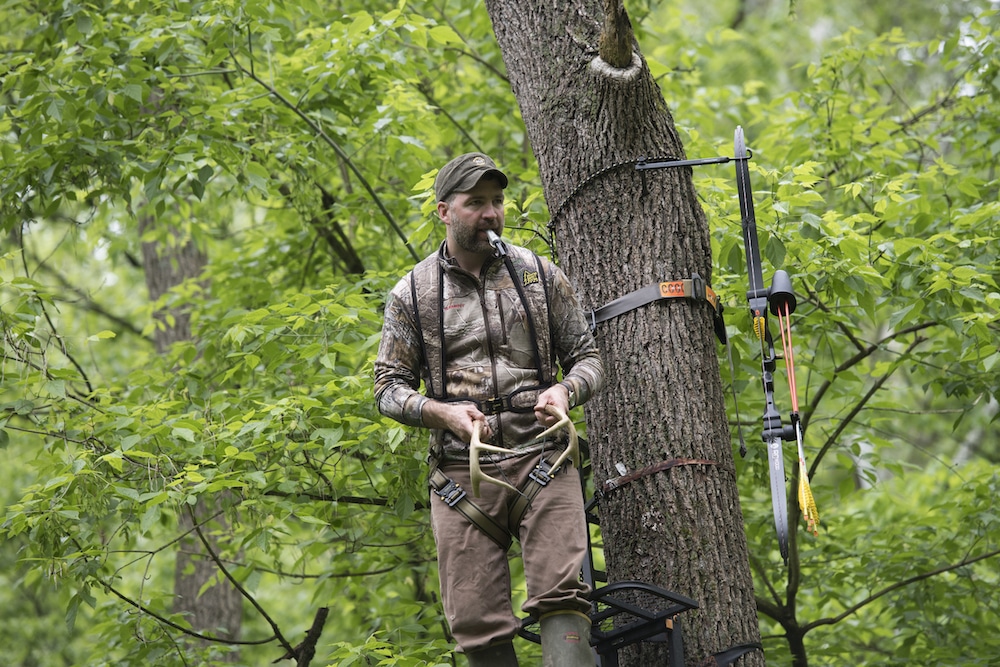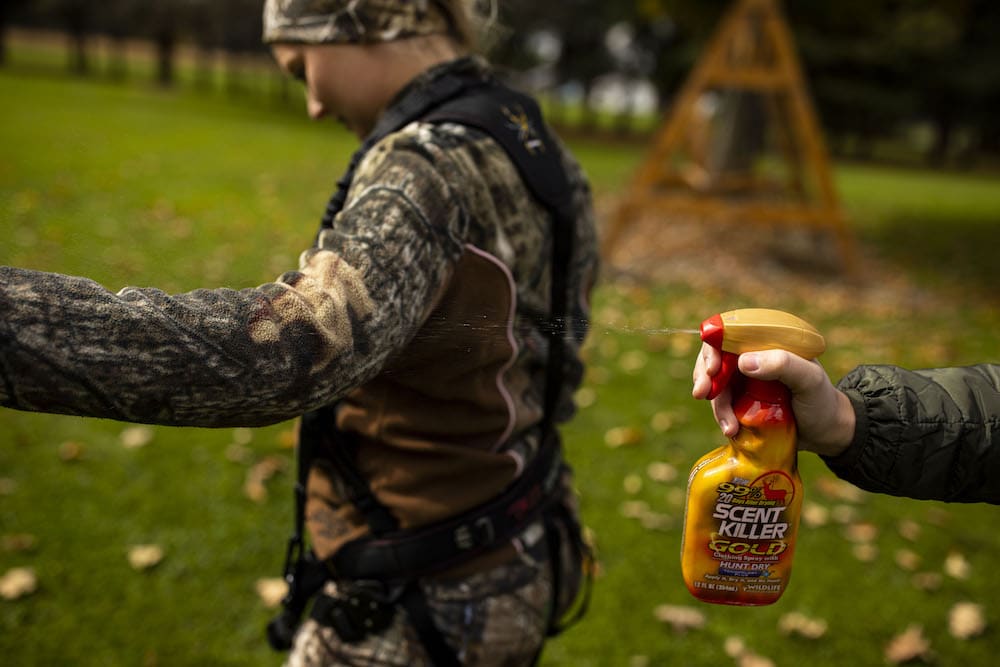Sitting quietly in a tree over a well-used deer trail is an incredibly effective bowhunting technique. Diligent bowhunters who put in their time to learn where bucks are moving often enjoy success by simply being in the right place at the right time. But if your target buck doesn’t appear where you want him, special tactics can lure him to you.
Calling, decoys and scents can all help bring a buck within bow range when used properly. Here’s an overview of different techniques and when to use them.

Choose your deer calls according to the aggression level of the rut season. Photo credit: BU
Bowhunters have several types of calls at their disposal including bleats, grunts, snort-wheezes and rattling antlers. Calling is a tricky proposition. Sometimes it is ridiculously effective; other times deer act like they didn’t even hear the call or even turn and walk away from it. It really depends on their mood. Therefore, it’s usually best to start with subtle bleats or grunts that simply say to a deer,
I’m here.” A nonaggressive approach may bring in deer, and even if it doesn’t, it shouldn’t scare them. Snort-wheezes and rattling are aggressive techniques that can draw rut-crazed bucks like magnets, but if deer aren’t in the mood for fighting or breeding, these calls can do more harm than good.
In the early pre-rut stage, before bucks are interested in breeding, calling has limited effectiveness. A couple of quiet bleats or grunts may pique their curiosity, but don’t overdo it. Subtle is usually better. However, as the rut ramps up, calling becomes more effective. Bucks are ready to breed before the first does come into estrus, so plaintive bleats can attract hormonally charged bucks. Likewise, grunts can attract the attention of dominant bucks looking to run off rivals and establish breeding rights.
As the seeking phase of the rut peaks, snort-wheezes may fire up dominant bucks and bring them to the call, but beware that not all bucks strive to be at the top of the pecking order. Some bucks — even large ones — are more submissive, and an aggressive snort-wheeze may chase them off.
Rattling is a loud calling technique that can draw bucks from great distances. It is best used right before and just after the rut kicks into high gear, when bucks are vying for dominance and breeding rights. It’s also best in areas with high buck-to-doe ratios where there is a lot of competition among bucks. In areas where there are plenty of does to go around, bucks generally aren’t as concerned about fighting for breeding rights.
And of course, many bowhunters employ a mouth bleat to stop deer for a shot. Brush up on your technique so you can learn to stop a buck at the critical moment.
Decoys are the perfect complement to calls. When a buck responds to a call, it expects to see a deer, so decoys add realism. Place your decoy where it is visible from a long distance to attract bucks. Open fields are ideal, but open hardwoods work too. Like calls, decoys come into their own in the late pre-rut and during the rut, when bucks are on the move and aggressive. If a cruising buck doesn’t see your decoy, a grunt, rattle or snort-wheeze can get his attention and the decoy can finish the deal.
Many bowhunters employ buck decoys to attract rival bucks. A dominant buck may rush in to drive off a subordinate, so use a decoy with small or medium-sized antlers. Place the ears back in an aggressive position to fire up rival bucks.
Bucks will approach your decoy from downwind. If possible, position the decoy where a rock, stream or other barrier prevents the buck from getting directly downwind from you, where it could smell you. Place the decoy upwind of and quartering toward you. The buck will approach the decoy head-on, which should give you a broadside or quartering-away shot as the buck passes you and goes toward the decoy. If it’s an aggressive dominant buck, it will likely come straight to the decoy. If it’s less sure of itself, it may still come to the decoy’s head but may circle a bit. Decoys are great for getting a good shot, since they tend to focus the buck’s attention away from your setup and movement.

Make sure you mask your scent before you enter the woods or handle any decoys. Photo credit: BU
Of course, a buck expects to smell the decoy as he approaches from downwind. First off, keep your human odor off the decoy. Spray it down regularly with scent-eliminating spray, store it in a scent-free container and handle it with latex gloves to prevent your scent from contaminating the decoy.
You can doctor up your decoy with dominant buck lure on the decoy’s tarsal glands (or even on the ground behind the decoy). Some bowhunters even add doe-in-heat scents to a buck decoy to really fire up a buck. Of course, doe-in-heat scent is a perfect addition to a doe decoy as well.
Scents aren’t just for decoys. They work just fine on their own. Using a scrape dripper depositing estrous doe scent over a real or mock scrape is a good way to get bucks in range. And scent-eliminating spray is almost mandatory for killing your human odor to keep deer from winding you. Cover scents can also help mask your scent to befuddle a deer’s nose. Use scents found within your area; for example, pine scent when hunting in pine forests.
Laying a scent trail to your stand is another good way to lure in a buck during the pre-rut or rut. Drag a cotton scent wick soaked in doe-in-heat scent behind you as you walk to your stand. A cruising buck may cut your trail and follow you right to your stand.
Calls, decoys and scents all have their place and can help attract bucks from afar or get them to close those last few critical yards into bow range. They won’t always work. Many times deer may ignore them if not in an aggressive mood. But when they do work, they can cause bucks to come charging right to you, making for an effective — and memorable — setup.